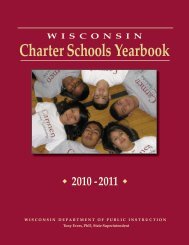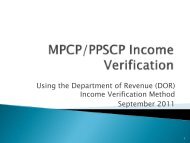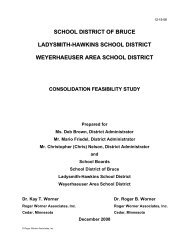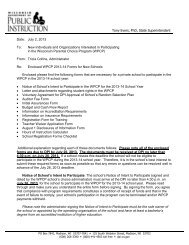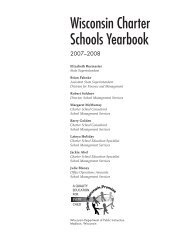2009-10 Yearbook - School Management Services
2009-10 Yearbook - School Management Services
2009-10 Yearbook - School Management Services
Create successful ePaper yourself
Turn your PDF publications into a flip-book with our unique Google optimized e-Paper software.
The staff members of non-instrumentality charter schools are not employees<br />
of the school district or chartering authority. Thus, they are not eligible to<br />
participate in the Wisconsin Retirement System and are not members of the local<br />
teachers union.<br />
G: Funding<br />
Most of the money that funds K–12 education in Wisconsin comes from state<br />
funds raised primarily through state income and sales taxes. The funds remaining<br />
come from other sources, including property taxes, federal aid, and local fees.<br />
In schools chartered by a school district, the contract or charter determines the<br />
amount of funding for the charter school each year. In some cases, the district’s<br />
per-pupil expenditure follows the student as he or she moves from a regular<br />
public school to a charter school. In other cases, the charter school functions with<br />
less money. This can happen if a charter school shares an existing district facility,<br />
and shares management costs with the school district, participates in district<br />
services such as co-curricular activities, special education, psychological services,<br />
and food service. The school district counts charter school students on its regular<br />
count for state aid purposes.<br />
In schools chartered by the city of Milwaukee, UW–Milwaukee, MATC, or<br />
UW–Parkside, the amount of funding is determined by state law. These non–<br />
school board sponsored/independent charter schools are funded from a<br />
proportionate reduction in state school aids from all 425 school districts. For the<br />
<strong>2009</strong>-20<strong>10</strong> school year, the amount is $7,775 per pupil for the independent charter<br />
schools and is paid directly to the operator of charter schools. The total amount is<br />
based on the number of eligible students attending the charter school. Several<br />
charter schools have received grants and gifts from community, state, and national<br />
organizations, foundations, businesses, and private individuals.<br />
H: Grants<br />
Since 1996, the Wisconsin DPI has received Public Charter <strong>School</strong>s Program<br />
(PCSP) grants from the U.S. Department of Education. In 1996, the DPI received<br />
a three-year grant for more than $6.4 million. In 1999, the amount received was<br />
more than $8.75 million for three years, and for the years 2002-2005, more than<br />
$27.7 million was awarded. The DPI received $52.5 million for the 2005-<strong>2009</strong><br />
four-year period. The DPI has been authorized to receive $85.95 million from<br />
<strong>2009</strong>-2014. Ninety-five percent of the grant funds are awarded in sub-grants to<br />
charter schools. These federal grant funds may be used for planning and<br />
implementation activities such as professional development, assessment<br />
strategies, curriculum development, and investments in technology. In some<br />
cases, a reasonable amount may be used in the renovation of facilities to bring<br />
them up to health and safety codes. Grants may generally be used to defray costs<br />
7



